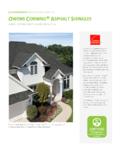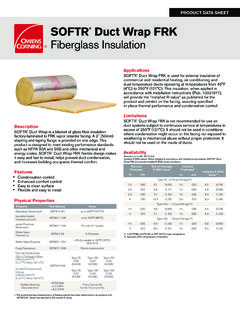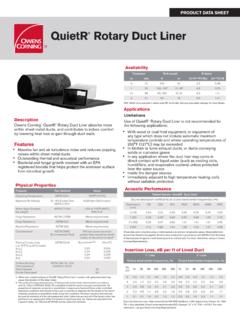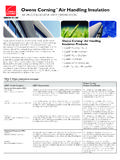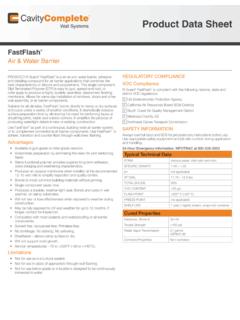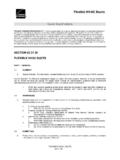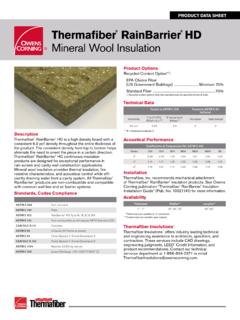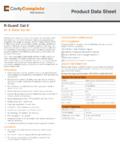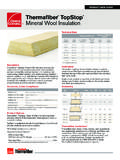Transcription of Owens Corning™ FIBERGLAS™ Pipe Insulation …
1 FIBERGLAS Pipe Insulation According to ISO 14025 This declaration is an environmental product declaration (EPD) in accordance with ISO 14025. EPDs rely on Life Cycle Assessment (LCA) to provide information on a number of environmental impacts of products over their life cycle. Exclusions: EPDs do not indicate that any environmental or social performance benchmarks are met, and there may be impacts that they do not encompass. LCAs do not typically address the site-specific environmental impacts of raw material extraction, nor are they meant to assess human health toxicity. EPDs can complement but cannot replace tools and certifications that are designed to address these impacts and/or set performance thresholds Type 1 certifications, health assessments and declarations, environmental impact assessments, etc. Accuracy of Results: EPDs regularly rely on estimations of impacts, and the level of accuracy in estimation of effect differs for any particular product line and reported impact.
2 Comparability: EPDs are not comparative assertions and are either not comparable or have limited comparability when they cover different life cycle stages, are based on different product category rules or are missing relevant environmental impacts. EPDs from different programs may not be comparable. PROGRAM OPERATOR UL Environment declaration HOLDER Owens corning declaration NUMBER DECLARED product Owens corning FIBERGLAS Pipe Insulation REFERENCE PCR PCR Building Envelope Thermal Insulation (June 1, 2014) DATE OF ISSUE August 21, 2015 PERIOD OF VALIDITY 5 years CONTENTS OF THE declaration product definition and information about building physics Information about basic material and the material s origin Description of the product s manufacture Indication of product processing Information about the in-use conditions Life cycle assessment results Testing results and verifications The PCR review was conducted by.
3 UL Environment Approved by Expert Review Panel 333 Pfingsten Road Northbrook, IL 60611 This declaration was independently verified in accordance with ISO 14025 by Underwriters Laboratories INTERNAL EXTERNAL Wade Stout, UL Environment This life cycle assessment was independently verified in accordance with ISO 14044 and the reference PCR by: Thomas Gloria, Industrial Ecology Consultants FIBERGLAS Pipe Insulation According to ISO 14025 product Definition and Information product Description FIBERGLAS Pipe Insulation is molded of heavy-density, resin-bonded inorganic glass fiber. The 36 long hinged sections are designed to insulate pipe with an operating temperature range from 0 F to 1,000 F (with heat-up schedule) in commercial and industrial buildings. The low thermal conductivity contributes to lower operating costs of mechanical equipment. Manufacturing Locations This environmental product declaration (EPD) represents the production of FIBERGLASTM Pipe Insulations manufactured at the Owens corning Newark Insulation Plant located at 400 Case Ave, Newark, OH 43055.
4 Application and Uses No Wrap FIBERGLASTM Pipe Insulation is available without a pre-applied jacket and is designed for field jacketing appropriate to the vapor control, damage or corrosion resistance requirements of the application. VaporWick Pipe Insulation is designed specifically for chilled water lines and below-ambient-temperature applications in hot/humid environments with operating temperatures from 32 F to 220 F. It has a special material that wicks moisture away from the FIBERGLASTM Insulation so it stays dry and effective. It can be installed directly on wet pipes, saving the time and hassle of a system shutdown. FIBERGLAS Pipe Insulation According to ISO 14025 ASJ (All Service Jacket) Max FIBERGLASTM Pipe Insulation has a durable, cleanable, poly-encapsulated paper jacket that doesn t support mold or mildew growth. The new SSL Max closure system was designed to work specifically with the jacket to provide a tight, reliable seal that doesn t need glue or staples.
5 It can tolerate intermittent, short-duration precipitation during construction. ASJ FIBERGLASTM Pipe Insulation has a factory-applied vapor retarder jacket with a double closure that provides a smooth, finished appearance. The double adhesive lap seal and two-part butt strip seal provide effective long term vapor sealing of the longitudinal and butt joints. Evolution FIBERGLASTM Pipe Insulation features a jacket that does not support mold or mildew growth. * Note: Evolution FIBERGLASTM Pipe Insulation and ASJ FIBERGLASTM Pipe Insulation will be retired in 2015. FIBERGLAS Pipe Insulation According to ISO 14025 Installation No Wrap: No Wrap FIBERGLAS Pipe Insulation is designed for field jacketing. The pipe section is open by the hinged sections, placed over the pipe, carefully aligned, and is secured by wires or bands, and vapor sealed where required. Outdoor applications must be protected from weather with weather proof jacketing.
6 VaporWick Pipe Insulation : VaporWick Pipe Insulation sections are opened, placed over the pipe, closed and secured with a pressure-sensitive adhesive closure. Auxiliary items include rolls of wick material for wrapping elbows and valves; VaporWick Pipe Insulation evaporation skirt (hula skirt) for verticals; and matching butt joint sealing tape for system closure. VaporWick Pipe Insulation must be installed following Owens corning VaporWick detailed installation instructions at ASJ Max, ASJ, and Evolution Jacketed: 1. Ambient application temperatures are from 25 F (-4 C) to 110 F (43 C). 2. Open the hinged sections and place the Insulation over the pipe, taking care not to get dirt, dust or moisture on the overlap area. 3. Pull the release strip from the lap. While preparing to close the Insulation , do not allow the adhesive to contact anything until the Insulation is properly lined up and closed over the pipe.
7 4. Seal the Insulation . Start by pulling the lap down at the middle until the adhesive touches the jacket. Press together. Rub firmly with nylon sealing tool or squeegee from the middle of the section toward the end, until the lap is securely adhered to the jacket. 5. Apply the matching butt strip centered over the adjoining pipe sections and rub with firm pressure to complete the positive closure. Note: After adhesive tack and when the butt strip is applied, it is critical that the closures are not re-opened and repositioned on the facing. Doing so will diminish the bond strength. FIBERGLAS Pipe Insulation According to ISO 14025 Production Material Content FIBERGLAS Pipe Insulation consists of two major components, the fiberglass, and the binder system. The FIBERGLAS Insulation is made from various inorganic minerals, which are referred to as batch chemicals.
8 The binder system consists of non-renewable organic materials. Table 1: Material Content of FIBERGLAS Pipe Insulation Materials Function Quantity (mass%) Non-Renewable Renewable Recycle Material Origin Transportation Mode Transportation (Miles) Cullet Glass Batch 48-51% North America Truck 120-150 Sand Glass Batch 14-17% North America Truck 20-50 Silicates Glass Batch 1-4% North America Truck 525-600 Soda Ash Glass Batch 3-6% North America Rail 1600 Borates Glass Batch 11-14% Global Rail 525-600 Oxides Glass Batch <1% North America Truck 525-600 Phenol Urea Formaldehyde Resin Binder 5-7% North America Truck 95-140 Ammonia Hydroxide Binder 1-3% North America Truck 95-140 Dust Suppressant Binder <1% North America Truck 95-140 Coupling Agent Binder <1% North America Truck 95-140 FIBERGLAS Pipe Insulation According to ISO 14025 Table 2: Material Content of Jackets by product Type Material Function Quantity(Mass%/m2) Non-Renewable Renewable Recycle Material Origin Transportation Mode Transportation (miles)
9 VaporWick Jacket Polymer Film 100% North America Truck 400-600 Fabric Wicking ASJ Max Jacket Polymer Film Exterior layer 25-28% North America Truck 400-600 Proprietary Core 37-40% North America Truck 400-600 Fiberglass Mat Reinforcement 22-25% North America Truck 400-600 Aluminum Foil Interior layer 10-13% North America Truck 400-600 ASJ Jacket High Intensity White Kraft Exterior layer 51-54% North America Truck 400-600 Flame Resister Adhesive 1-4% North America Truck 400-600 Fiberglass Mat Reinforcement 27-30% North America Truck 400-600 Elastomeric Polymer Barrier coating 3-6% North America Truck 400-600 Aluminum Foil Interior layer 11-14% North America Truck 400-600 Evolution Jacket Polymer Film Exterior layer 47-50% North America Truck 400-600 Polymeric Adhesive 1-4% North America Truck 400-600 Fiber Reinforcement 36-39% North America Truck 400-600 Aluminum Foil Interior layer 10-13% North America Truck 400-600 Material percentage for the Functional Unit RSI=1 is not applicable and would distort the data.
10 For jacketed products, the percent of jacket material varies as a function of product R-value and square foot weight. FIBERGLAS Pipe Insulation According to ISO 14025 Manufacturing Process Figure 1: Owens corning General Process Flow for FIBERGLASTM Products Raw Materials Acquisition Manufacturing of FIBERGLAS Pipe Insulation Binder application Fiberizing Fiber Forming Molten Glass Batch Material Melter (Furnace) Pipe Molding /Curing Jacket Application Distribution Packaging Finished product FIBERGLAS Pipe Insulation According to ISO 14025 Life Cycle Assessment product System and Modeling Functional Unit For the pipe Insulation a declared unit must be used in place of a functional unit because the physical configuration of pipe Insulation affects thermal resistivity; thus, it is virtually impossible to define a single, generic functional unit that is representative of the all possible configurations.
